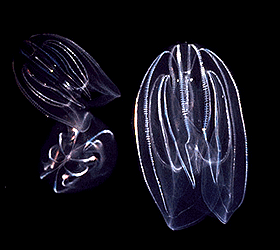Invertebrate
Zoology Ctenophora
Animals
in phylum Ctenophora are called sea walnuts or comb jellies. The approximately 100 described species are all
marine. Most ctenophorans have a spherical
form, although several groups are flattened and/or elongate.
Comb jellies are named for their unique feature: plates of fused cilia, known as combs, which run in eight rows up and down their bodies. The combs act like tiny oars, propelling the organism through the water. Like various other marine organisms, many ctenophores are bioluminescent. In addition, the combs produce a rainbow effect. This is not bioluminescence, but is the result of light being scattered by the moving cilia.
Ctenophores are voracious predators feeding on copepods and the larvae of different organisms (e.g., fish larvae). Many comb jellies have a single pair of branched tentacles that they use like fishing lines to catch prey. The tentacles are lined with sticky cells called colloblasts and unlike jellies, they lack stinging cells.
In the 1980s, an invasive species of ctenophore (Mnemiopsis leidyi) was accidently introduced into the Black Sea in the ballast waters of ships. Without natural predators to keep Mnemiopsis in check, the ctenophores quickly increased and outcompleted the native fishes by eating the zooplankton before the native fish larvae hatched. Mnemiopsis ravaged the ecosystem in less than ten years, not only by eating the plankton that the native fish larvae feed on, but also feasting on fish eggs and larvae. Mnemiopsis populations in the Black Sea have finally come under control in the last few years thanks to the "spontaneous" introduction of a new predatory ctenophore, Beroe ovata, which appears by its morphology to also be an import from American waters. However, Mnemiopsis has since invaded the Adriatic, Baltic, Caspian, and North Seas.
 |
1.
Diploblastic, tissue-level of organization
2.
Biradial symmetry
3.
Gelatinous mesoglea between the epidermal
and gastrodermal tissue layers
4.
Gastrovascular cavity 5. Decentralized nerve net |
Return to the Invertebrate Zoology
Homepage